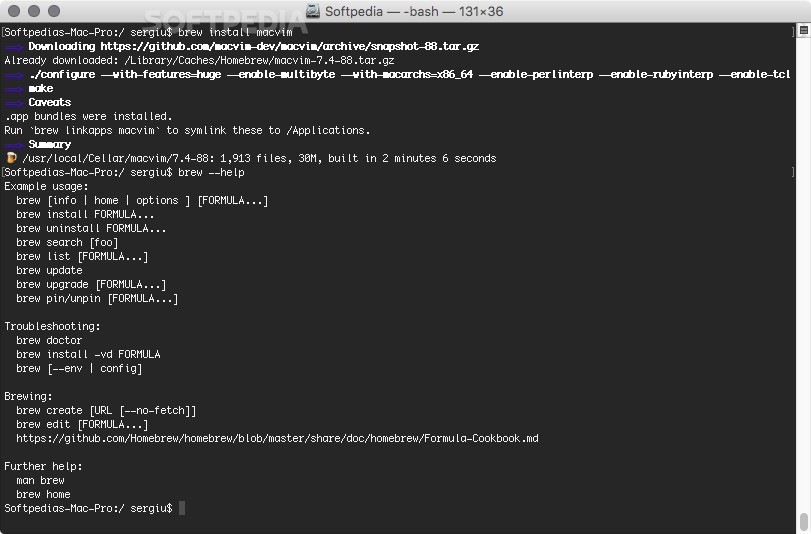

To enable or disable System Integrity anycodings_homebrew Protection, you must boot to Recovery OS anycodings_homebrew and run the csrutil(1) command from the anycodings_homebrew Terminal.īoot to Recovery OS by restarting your anycodings_homebrew machine and holding down the Command and anycodings_homebrew R keys at startup. System Integrity Protection status: enabled. You can check whether System Integrity anycodings_homebrew Protection is currently enabled on your anycodings_homebrew system by running the following command anycodings_homebrew in the Terminal: $ csrutil status System Integrity Protection can be anycodings_homebrew configured using the csrutil(1) command. Alternative to opening Rosetta terminalĪnd that is all there is to this post.Try disabling System Integrity anycodings_homebrew Protection.
#Homebrew for mac 10.13 install
Run: arch -x86_64 pip install -upgrade pip setuptools 3. Additional step for people having problems with Python (<3.9) I also have added them to my path with the M1 version before the Intel version so that I use native packages, if available, else I use the Intel-based emulated version for it. Mbrew='arch -arm64e /opt/homebrew/bin/brew'Īnd use them as mbrew install or ibrew install to install packages as needed. I have configured the above two commands as aliases for my convenience: ibrew='arch -x86_64 /usr/local/bin/brew' $ curl -L | tar xz -strip 1 -C homebrewĪnd with that installed, we have Homebrew up and running and we can start using the architecture flag for our installations.įor installing the packages using Intel, you can now use: arch -x86_64 /usr/local/homebrew/bin/brew install Īnd for using Homebrew on the M1 mac: /opt/homebrew/bin/brew install Additional possible configurations 1. So I used the tar installation to manually install Homebrew first (knowing) that it is installed in the /usr/local directory. So my next step was to use: $ arch -x86_64 /bin/bash -c "$(curl -fsSL )" It would be great to do everything in one application and who likes doubling their own work? Rosetta gives us the ability to prefix commands with the arch -x86_64 prefix to run applications in the emulated mode. Having two terminal applications is never fun. This version did not work correctly for me for some reason, but I did not dive much into it since I preferred having a single terminal application anyway. We can start using the Rosetta terminal as usual for this then, installing Homebrew and other applications. In the window that opens, we will select the checkbox for “Open using Rosetta”, and then close the window. Next, we will right click the new terminal and select “Get Info” or press Command + I. We will rename it to something like “Rosetta Terminal”. In the finder, we will right-click on Terminal (or iTerm) and create a duplicate of the application. I prefer the latter, but it is up to you what you choose to do. There are a couple of ways to do this: Creating a different terminal for Rosetta related stuff and doing it in the same terminal and adding a few aliases. $ /bin/bash -c "$(curl -fsSL )" Installing Homebrew for the Rosetta emulatorĪfter installing Homebrew on the M1 mac, we need to have a separate installation for the Rosetta emulator. Installing Homebrew on the M1 mac was pretty straightforward from the homepage. These are somewhat hardcoded locations for Homebrew and there is not much we can do about it.

#Homebrew for mac 10.13 code
The two locations live independently of one another: /usr/local for rosetta-emulated (Intel) code and /opt/homebrew for ARM64. If I did not do so, I got the following error on brew when trying to install an application that was not available for the M1 architecture: Error: Cannot install in Homebrew on ARM processor in Intel default prefix (/usr/local)! brew tap will never create shallow clones (as shallow clones. brew alias, brew autoupdate and brew command-not-found are official external command taps. Other changes since 3.1.0 I’d like to highlight are the following: brew link -HEAD links the HEAD version of a formula. Though Homebrew has been updated for the ARM architecture, it does not simply work out of the box with the architecture fl as well as the Intel emulated Rosetta. Various deprecations, disables and code deletions for Homebrew 3.2.0. usr/sbin/softwareupdate -install-rosetta agree-to-license (root permission required) usr/sbin/softwareupdate -install-rosetta I installed it using the terminal itself. But since I was working mostly in the terminal, I did not get the prompt to do so. The user does get prompted for the installation of Rosetta when installing an Intel-based application.

Rosetta 2 sadly does not come pre-installed and we have to explicitly install it. After going through quite a few Stackoverflow questions and Github issues, this is what worked for me for installing Intel-based packages on the M1 mac. This might not be the best approach to doing things in the future, but this is the ecosystem’s state right now.


 0 kommentar(er)
0 kommentar(er)
